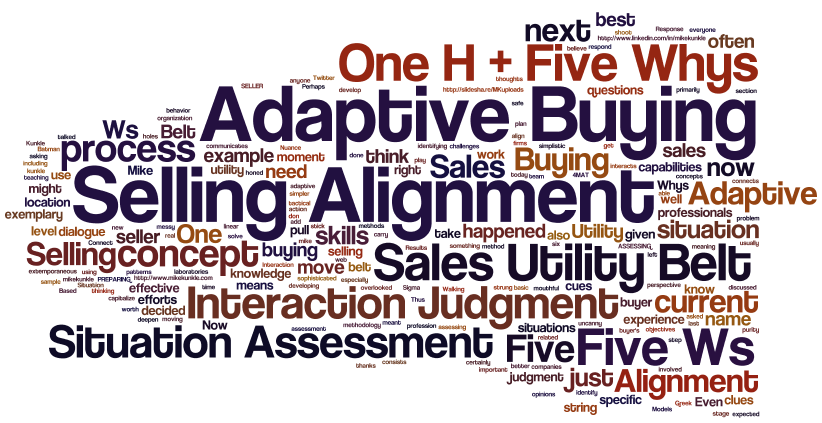Adaptive Buying and Selling Alignment

I’ve been thinking about this concept for about six months and have finally decided to document it here now, even as work in progress.
The name I’ve given my concept is Adaptive Buying and Selling Alignment. It’s a mouthful; I know. Perhaps that name won’t stick, but it’s a “working title” and I like it for now.
It’s simpler than it sounds. I think of Adaptive Buying and Selling Alignment as a string that connects related dots, which are often discussed individually, but aren’t usually strung together. It consists of:
- The concept of a sophisticated seller identifying his prospect’s buying process (Situation Assessment) and using his or her experience and judgment (Interaction Judgment), adapting his selling efforts to it . This isn’t new by any means, but given the current buyer’s market, it’s being talked about a lot more now.
- The power of the Five Ws and One H (Who, What, Why, When, Where and How) and Five Whys. This is a method for conducting a diagnosis and encouraging dialogue, which dates back to Roman and Greek philosophers. Even today it is a framework for teaching methods such as 4MAT and for process work, including Six Sigma.
- My concept that exemplary sales professionals carry with them a “Batman Utility Belt” of sorts (think: Sales Utility Belt), loaded with effective mindsets, knowledge, skills, and capabilities, but also with something critical that is often overlooked — experience and judgment.
These exemplary performers possess an uncanny ability to use cues and clues to identify where they are in the buying process, diagnose the current situation (what just happened) and reach into their utility belt and pull out just what they need at that moment (their sales methodology and skills), to move the interaction forward to the next step or next stage in the buying process). Therefore, they are adaptive, and align their selling efforts to the situation. Thus the name: Adaptive Buying and Selling Alignment.
Sales professionals, and frankly, anyone who interacts and communicates with other people (meaning, everyone), often have to respond “in the moment” using their best judgment based on experience and effective behavior patterns honed through practice. While this is primarily extemporaneous, there are ways to prepare for situations with some forethought. Here is a very basic example of how the Five Ws and One H might come into play, in assessing a current situation.
ASSESSING THE BUYER SITUATION:
- WHO: Who’s involved? What level in the organization are they?
- WHAT: What are their top objectives (moving toward a goal) and challenges (solve a problem or avoid one)?
- WHY: Why are these important to them now?
- HOW: How are they planning to address this, or what are they considering? How will they fund it?
- WHEN: When do they plan to take action?
- WHERE: Where are the buyers in their process? How do you know (cues and clues)?
PREPARING YOUR SELLER RESPONSE:
Based on that and the current situation (what happened last, what I anticipate might happen next, or what just happened), what do I do next?
- WHAT: What’s my strategy? What’s my next tactical move? What do I need that I don’t have at my disposal? How do I get it?
- WHY: Why is that the right move? What’s my rationale?
- WHO: Who do I do it with? (From the buyer and seller team perspective)
- HOW: How should I do it? (Models / capabilities / to what level of mastery)
- WHEN: What’s the best timing? (Now, later, when)
- WHERE: Where should I do it? (Now – current location, by phone, web conference, in-person, other specific location)
Adding the Five Whys to the Five Ws and One H can certainly deepen any assessment (and any dialogue, if done well and not as an interrogation). Of course, the above is a very simplistic example and you and I could both shoot it full of holes or add to it. It’s just meant as a sample. Also, once you start asking questions, the process is not linear. Even in the over-simplified example above, you’ll noticed I asked How in the string of What questions (Seller Response section). In actual use, this is expected and recommended… purity is best left for text books and laboratories; the real world is messy.
Over the coming weeks and months, I’ll be further developing the concept of Adaptive Buying and Selling Alignment, how to load a Sales Utility Belt, how to capitalize on the Five Ws and One H + Five Whys, and how to develop your Situation Assessment skills and Interaction Judgment to pull out the right knowledge and skills from your utility belt, when you need it.
Walking My Talk on Sales Nuance
I’ve also decided to create several companies, both seller and buyer firms, as well as some buying/selling situations, to be able to provide better, specific examples when demonstrating concepts and recommending approaches. This will take some time, so won’t be ready for awhile, but I believe it will be worth it.
What do you think of all this – especially the Adaptive Buying and Selling Alignment concept? I’m open to your opinions and thoughts, if you care to share.
In the meantime, thanks for reading, be safe out there, and by all means, let’s continue to elevate our sales profession.
Mike
_____________________________________________________
Mike Kunkle
Transforming Sales Results with Clear Insight & Focused Execution
Contact:
214.494.9950
<mike at mikekunkle dotcom>
Connect:
LinkedIn: http://www.linkedin.com/in/mikekunkle
Twitter: https://twitter.com/mike_kunkle
Google+: http://gplus.to/mikekunkle
Blog: https://www.mikekunkle.com
Slideshare: http://slidesha.re/MKuploads

